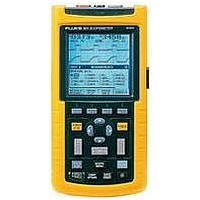FLUKE-125/003 Fluke, FLUKE-125/003 Datasheet - Page 2

FLUKE-125/003
Manufacturer Part Number
FLUKE-125/003
Description
SCOPE METER, 40MHZ, 2 CHANNEL, 25MSPS
Manufacturer
Fluke
Type
Digitalr
Specifications of FLUKE-125/003
Scope Type
Digital Hand Held
Scope Channels
2 Scope
Bandwidth
40MHz
Meter Display Type
LCD Monochrome
Sampling Rate
25MSPS
Input Impedance
1Mohm
Rise Time
8.75ns
Input Voltage
1kV
Brand/series
ScopeMeter®/120 Series
Configuration
Handheld
Display Type
Monochrome LCD
Memory
512 pts
Number Of Channels
2
Sample Rate
0.025 GS/s
Lead Free Status / RoHS Status
na
Lead Free Status / RoHS Status
na
Technical Specifications 190C and 190B Series
Oscilloscope Mode
Vertical Deflection
Bandwidth limiter: User selectable: 10 kHz, 20 MHz
or off
Number of inputs: 2 plus external trigger. All inputs
isolated from each other and ground.
Input coupling: AC or DC, with ground level indicator
Input sensitivity: 2 mV/div to 100 V/div (Fluke 190C
Series); 5 mV/div to 100 V/div (Fluke 190B Series)
Normal/Invert: On both input channels; switched
separately
Variable attenuator: Variable gain on input channel A
Input voltage: 1000 V CAT II, 600 V CAT III rated -
See “general specifications” for further details.
Vertical resolution: 8 bit
Accuracy: ± (1.5% of reading + 0.04 x range/div)
Input impedance: 1 MΩ ± 1% // 15 pF ± 2 pF
Horizontal
Display and Acquisition
2 Fluke Corporation
Maximum record length: 3000 points per input in
Scope-mode; 27,500 points per input in
ScopeRecord
Accuracy: ± (0.01 % of reading + 1 pixel)
Glitch capture: 50 nsec (at 5 µsec/div to 1 min/div);
250 nsec (at 2 min/div)
Visible screen width: 12 divisions
Waveform mathematics: A + B, A - B, A * B, all
with user selectable scaling of resultant; A versus B
(X - Y-mode); Frequency Spectrum using FFT analysis
(190C only)
Acquisition modes: Normal, auto, single shot,
ScopeRecord
compare, waveform compare with automatic
“Pass / Fail testing” (in 199C and 196C only)
Trigger and Delay
Source: Input A, input B, external trigger input.
All input references isolated from each other and
from ground
Modes: Automatic Connect-and-View,
single shot, edge, delay, video, video line, selectable
pulsewidth, dual slope (190C only), N-cycle (190C
only)
Bandwidth
Rise time
Maximum
real-time
sample rate
Number of
digitizers
Time base
range
Display
Display modes
Persistence
modes
™
™
short/medium/long/infinite
roll mode (5 ms/div to 2 min/div)
roll, glitch capture, waveform
Fluke 199C
Fluke 199B
Fluke 199C
Fluke 199B
200 MHz
2.5 GS/s
Digital Persistence:
1.7 ns
ScopeMeter 190C/190B Series and ScopeMeter 120 Series
Input A, Input B, dual, average, Replay
Full Color LCD
2
Fluke 190C
144 mm
to 5 s/div
5 ns/div
Fluke 196C
Fluke 196B
Fluke 196C
Fluke 196B
100 MHz
1 GS/s
3.5 ns
2
™
free run,
Monochrome LCD
Fluke 190B
Persistence
Fluke 192B
Fluke 192B
144 mm
on / off
500 MS/s
10 ns/div
to 5 s/div
60 MHz
5.8 ns
2
Connect-and-View
that recognizes signal patterns, automatically sets up
and continuously adjusts triggering, time base and
amplitude. Automatically displays stable waveforms of
complex and dynamic signals like motor drive and
control signals.
Video triggering: NTSC, PAL, PAL+, SECAM. Includes
field 1, field 2 and line select.
Pulse width triggering: Pulse width qualified by time.
Allows for triggering <t, >t, =t, ≠t, where t is selec-
table in minimal steps of 0.01 div. or 50 nsec.
Time delay: One full screen of pre-trigger view or up
to 100 screens (= 1200 divisions) of post-trigger delay
Dual slope triggering: Both rising and falling transi-
tions, when crossing the trigger level, initiate an
acquisition (190C only)
N-cycle triggering: Triggers on N-th occurrence of a
trigger event; N to be set in the range 2 to 99 (190C
only)
Automatic Capture of 100 Screens
The instrument ALWAYS memorizes the last 100
screens (no user setup required). When an anomaly
occurs on screen, the REPLAY button can be pressed
to review the full screen sequence over
and over.
or intermittent anomalies and will operate in
“baby-sit” mode and will capture 100 events.
waveform compare mode to store only matching
(“Pass”) or only non-matching (“Fail”) acquired wave-
forms in the replay memory bank for further analysis.
Replay: Manual or continuous replay. Displays the
captured 100 screens as a “live” animation or under
manual control. Each screen has date- and time-stamp.
Replay storage: Up to 2 sets of 100 screens each
can be saved for later recall and analysis
FFT - Frequency Spectrum Analysis
(190C only)
Shows frequency content of oscilloscope waveform
using Fast Fourier Transform
Window: Automatic, Hamming, Hanning or None
Automatic window: Digitally re-samples acquired
waveform to get optimum frequency resolution in FFT
resultant
Vertical scale: Linear / Logarithmic, in volts
Frequency axis: Logarithmic; frequency range auto-
matically set as function of timebase range of oscillo-
scope
Waveform Compare and Pass/Fail Testing
Waveform compare: Provides storage and display of a
reference waveform for visual comparison with newly
acquired waveforms. Reference is derived from an
acquired waveform and can be modified in the
ScopeMeter or externally using FlukeView
Pass/Fail Testing (199C, 196C): In waveform compare
mode, the Color Scopemeter can be set up to store
only matching (“Pass”) or only non-matching (“Fail”)
acquired waveforms in the replay memory bank for
further analysis.
Instrument can be set up for triggering on glitches
Alternatively, the 199C and 196C can be set up in
™
: Advanced automatic triggering
®
Software.







